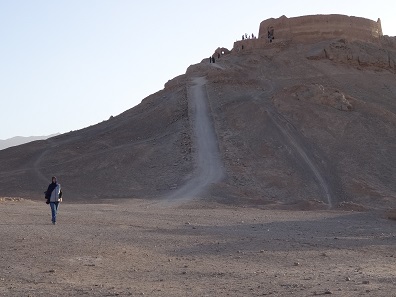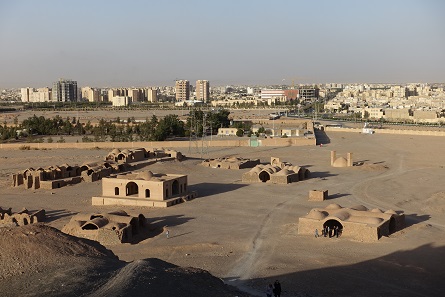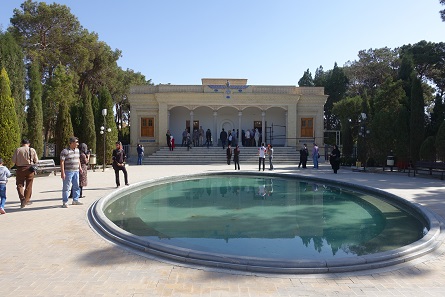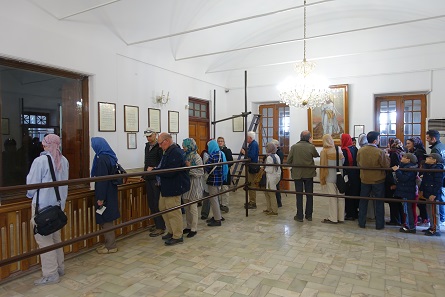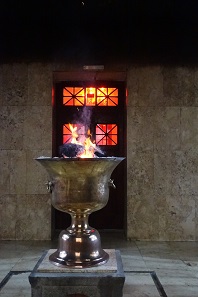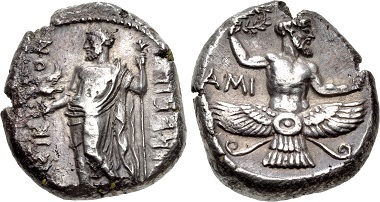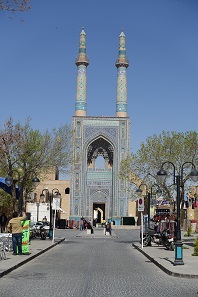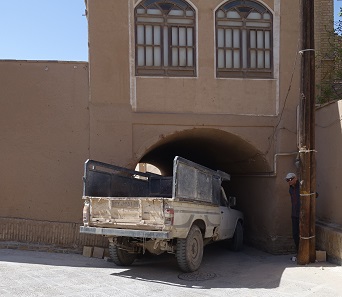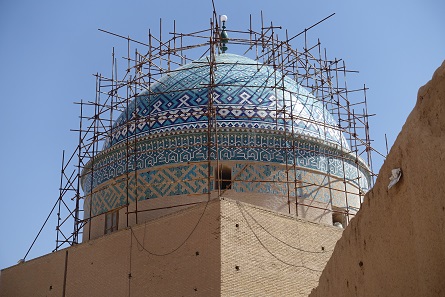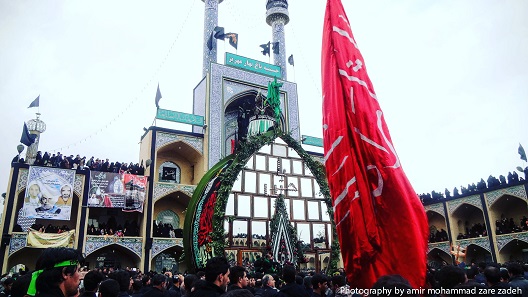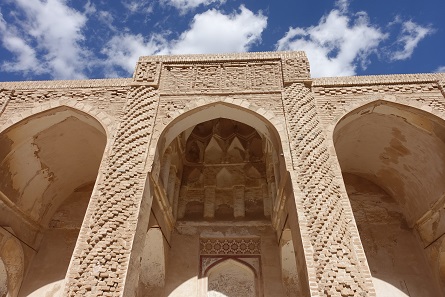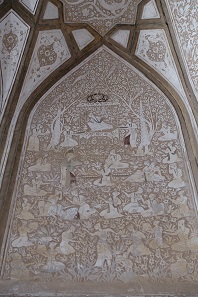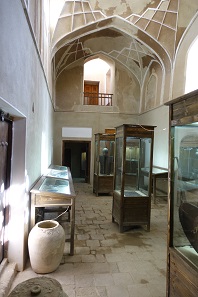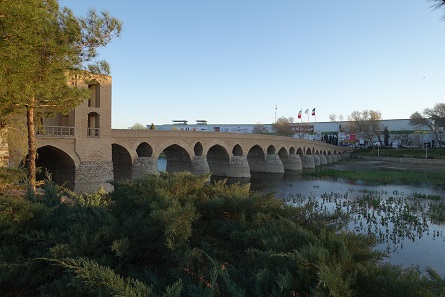by Ursula Kampmann
translated by Teresa Teklic
February 16, 2017 – The Persian founder of the Zoroastrian religion has become part of German general knowledge with Nietzsche, Richard Strauss, and Stanley Kubrick at the latest. Although knowledge usually means no more than familiarity with the name. That Zoroastrianism is still a religion with about 150,000 followers today, many of which live in India, the USA and of course Iran, only few people know. The largest centre of Zoroastrianism is Yazd, which we visit in this episode.
A tower of silence. Photo: KW.
Thursday, 17 March 2016
At around 5.00 pm we reached Yazd and drove straight to the towers of silence, where the Zoroastrians laid their dead to rest by leaving their corpses to be eaten by vultures. In this way neither the soil nor the fire was contaminated with a corpse. It was late afternoon and the light was beautiful. The derelict clay buildings, in which the followers of Zarathustra prepared their dead before leaving them to the birds on the towers of silence, lay peaceful in the last, warm light of the day. Somehow being in this place made this “heavenly funeral” seem incredibly romantic and right.
In the buildings at the foot of the towers of silence, the corpses were prepared, i.e. chopped up into smaller pieces. Photo: KW.
This kind of funeral is of course prohibited today. And I can see why. I can perfectly imagine how I would react if I stumbled across a human arm in my front garden, dropped by a vulture… And the city has grown really close to the towers of silence.
We reached the hotel already at 6.00 pm – really early by our standards. It was an ultrafashionable, modern building. Accordingly you could find anything to the tourist heart’s desire: a well-sorted boutique with scarfs of all sizes and different kinds of fabric, a spotlessly clean bathroom, a TV with a German (!) channel. But it wouldn’t be Iran if they hadn’t forgotten to include a window catch. Which means you couldn’t close the window (not an unimportant detail, considering today’s temperature). But we found a solution to our problem: we took the heavy suitcase stand and moved it right in front of the window, barring it. Let’s hope it is heavy enough to keep the wind from pushing open the window.
Friday, 18 March 2016
It was. We had a good night’s sleep, undisturbed by the wind, and learned in the morning that the window catches in all other rooms had been missing as well. The solutions that our travelling companions had come up with were no less creative than ours. Germany truly is a nation of engineers.
Fire temple. Photo: KW.
Our first destination today was the fire temple in the centre of Yazd. I was really curious, after all Zoroastrianism is the oldest religion that still exists. I was expecting a building as old as the hills and with the patina of centuries. But my expectations were disappointed. The temple was from the 19th century. It was donated to the followers by their Indian fellow believers and it says “cost-efficient” more than “impressive architecture”.
Waiting line at the fire temple… Photo: KW.
Yet, the demand was enormous, at least by Iranian standards. We waited close to half an hour behind a large American travel party.
…for a glimpse of the sanctum. Photo: KW.
I can’t really say that the inside was worth the wait. We saw a picture of Zarathustra from the 19th century and a big glass window behind which a fire was lit on a small altar. Which, I admit, I should have expected from the “fire worshippers.”
Hormuzd II, 303-309. Drachm. Rv. fire altar with bust. From Künker sale 273 (2016), Nr. 427.
To them the holy fire is a symbol of complete purity, which makes it a more worthy object of worship than anything else. And imagining how we impurify the fire by burning corpses in it must give dedicated Zoroastrians the creeps.
The reverse features Ahura Mazda as we know him from Persian depictions. Yet, the coin was minted in Issus (Cilicia) under the Persian satrap Tiribazus. From CNG sale 97 (2014), 257.
The content of the teachings of Zarathustra is pretty much the theme of every good Hollywood flick. It is about the eternal struggle between good and evil, in which the good persists and the good characters are rewarded: Ahura Mazda, the wise lord, created the world and sent out six good spirits, virtue, righteousness, good purpose, wisdom, possession, and health. They were originally meant as gifts to all those devoted to Ahura Mazda. But then evil Ahriman entered the scene, a combination of the Christian devil, Sauron, and Darth Vader. He sent out his six evil spirits to lead humans into temptation. Every human being has to decide between Ahura Mazda and Ahriman before each of his or her actions. The whole humankind is the material from which Ahriman and Ahura Mazda recruit their armies for this battle.
But fear not, there is a happy ending: after four times 3,000 years the day of final judgment will take place. On this day, the good in the world will be rewarded, the evil punished.
A look at the exhibition that was curated with a great attention to detail. Photo: KW.
Of course you could read about the whole thing in much greater detail – and in somewhat less solemn words – in the adjacent museum. Large museum panels in English and Farsi had been put up there. And please don’t get me wrong: we foreigners were clearly outnumbered! Countless Iranian visitors had come to learn more about Iran’s oldest religion. And they read the text panels from beginning to end! By the way, there must be some sort of connection between Zoroastrians and the Swabian housewife. Cleanliness is almost a religious mission. This means that Yazd has the cleanest toilets in all of Iran – and that is not in the least to say that the others had all been dirty.
Entrance to the mosque. Photo: KW.
The bus transported us the short way from the fire temple to the Jame Mosque of Yazd with its fantastic entrance made of colourful tile mosaics. I could have sat in front of the entrance for hours indulging in the details.
Intercultural communication: Germany-Iran. Photo: KW.
Inside several bright girls in black hijabs approached me and talked to me. Intercultural communication between women in Iran is pretty straightforward after all. Sometimes I think they should send all the diplomats and politicians home and have a few mothers sit down and talk about the problems…
The old town is not really made for car traffic, which of course doesn’t keep a single car driver from passing through even the remotest alley. Photo: KW.
Next on the agenda was a tour through the city’s old town, which demanded the utmost herding skills from our local guide and our Ms Hodel. Their small herd of tourist sheep spread out in all directions in next to no time. Some wanted to take a photo from a very specific angle at all costs (of course an absolute must-do, considering the special incidence of light!), others wanted to step into a shop real quick (we still hadn’t reached our maximum amount of souvenirs), and still others were grabbed by the arm by random Iranians dying to take a picture with them – with or without baby in their arms.
The scaffolded dome of a mausoleum. Photo: KW.
We passed by a beautiful mausoleum – which had a women only day on Wednesdays. No man is permitted to enter the construction site on this day. We didn’t, but only because it was closed due to restoration works.
Nakhil, decoration-less on a square in the city centre. Photo: KW.
On our walk we came across very strange objects again and again, and we couldn’t imagine what their purpose might be. An archaeologist would now ramble on something or other about “religious” or “children’s toy.” And 50% of it would be correct indeed. What we were looking at was not an Iranian version of a climbing frame, but a Nakhil.
A similar Nakhil in action, picture taken on 4 November 2014. Photo: Amir Mohammad Zare Zadeh / CC-BY 4.0 Int.
The Nakhil is part of the most important holiday of the Shiites. It forms part of a procession which is held on the occasion of the defeat and death of Hussein in the Battle of Karbala. It is decorated and solemnly carried around just like our Stations of the Cross in Spain and Sicily.
Carrier of a Christian Station of the Cross at a procession in Trapani. Photo: KW.
It occurred to me that there might have been a mutual influence of the cultures behind this ritual. Fat chance! The Muslims who ruled in Spain and Sicily were Sunni Muslims and they know nothing of a mourning procession for Hussein. So the pious followers of two different religions have developed a very similar (and painful) ritual entirely independent of one another. Which brings us back to Nietzsche and his Zarathustra, in which he states that Christians needed to look more redeemed to make him believe in God.
Anyhow, somehow Ehsan and Ms Hodel managed to round us up and drive us back to the bus. And that without losing any one of us! Good job!
The ancient Mosque of Nain. Photo: KW.
We took our lunch break in Nain, whose most outstanding feature is a very old mosque. So I looked inside, realized that it had an immensely interesting architecture – still in the Arabic style (!) – and then realized that I’d already seen a whole lot of mosques on this journey. And then I sat down in the forecourt in the sun and waited until the rest of our group had internalized enough of the architectural details.
Paradisiacal life. Painting in the Museum of Folklore in Nain. Photo: KW.
But the small Museum of Folklore across the street was awesome! It was housed in the mansion of a rich man so that we got to see the incredible splendour in which the rich citizens in the 17th and 18th century lived.
A look into the small museum. Photo: KW.
The rooms on the ground floor did not yet give anything of the former splendour away. They housed a number of more or less replaceable ethnological objects, among them also a few coins which were in such bad condition that I simply refused to photograph them. But the reception hall on the first floor was furnished with the most elaborate wall paintings. And if I hadn’t already written quite as much in this episode, I would show you more of them.
We left Nain for the last long overland drive to Isfahan on the bus. And I admit, I’m not going to miss these bus rides. Of course the panoramic views of the landscape we passed were often fantastic. But the climatic conditions? Awful! In the bus you could practically choose between two settings, “sauna” and “arctic.” Unfortunately not for everyone because there were different microclimates: if it was refreshingly cool in the back, it was Antarctica for those in the front. If, on the other hand, the A/C was set to a level which permitted the guests in the front rows to put away their hats and gloves again, those in the back were sweating to a degree that you otherwise get only in the best saunas. This occasionally led to a certain resentment among the group members. If it hadn’t been such a fantastic group, the lingering resentment could have easily grown into a full-blown argument…
One of the many beautiful bridges of Isfahan. Photo: KW.
We made it to Isfahan without the predicted great traffic jam and even had time enough to visit the city’s two most important bridges. The oldest one, whose foundation walls are said to date back to Sassanid times, and one from the time of the Safavids, which was beautifully adorned with small pavilions. Water was flowing underneath both bridges – thanks to the Persian New Year’s celebration! What may not sound very surprising to our ears is a constant public nuisance for the citizens of Isfahan. Their river, their pulse of life after all has no water since the government keeps it back in a barrier lake to supply Tehran with sufficient drinking water.
In the next and last episode of the Iranian travelogue I will tell you how Isfahan was all prettied up for Newroz, the Iranian New Year’s celebration.
You can find all episodes of my Iranian travelogue here.




